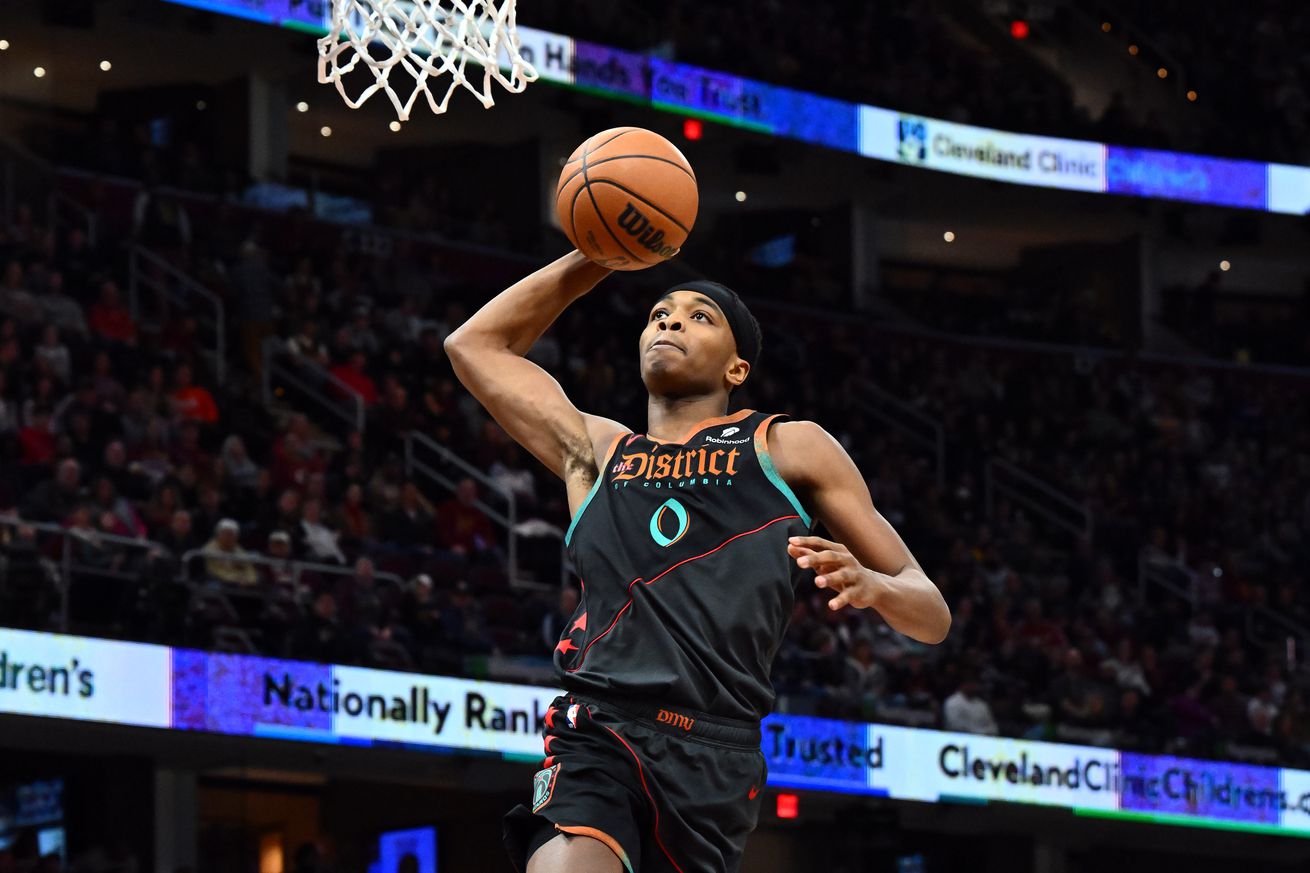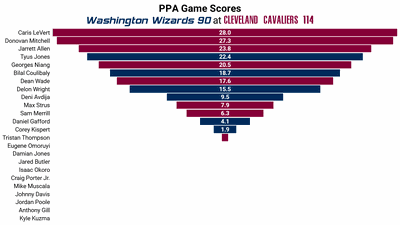
Stats, analysis, commentary.
Let’s see, the Wizards lost by 39 to the Cleveland Cavaliers on Wednesday and then by 24 last night. If they played again on Sunday — and maintained their differential progression — they’d lose by only nine. Then, if the played again on Tuesday…
Writing about individual games is almost irrelevant. Scrutinizing who did good stuff and who didn’t is kinda beside the point. The Wizards are bad and few of the players on the roster will be around if they ever manage to be good.
I see three possibilities for who might stick around as part of The Rebuild: Bilal Coulibaly, Deni Avdija, and Daniel Gafford. I could see Avdija and Gafford in useful, non-starring roles. Coulibaly, being younger and not yet established, still holds tantalizing potential. He could be a star, or he could be a defensive role player.
With the utter collapse of Jordan Poole, and Kyle Kuzma’s painful reversion to his mean, the bigger side experiments for the season are largely resolved. The hope that Poole could make this “his” team and leap into stardom is dashed. Maybe next year, if he’s willing to work for it.
The notion that maybe Kuzma could be more than a sixth man or a decent starter playing off a couple superstars is similarly gone. He’s had a chance to be The Guy on offense, he played the best basketball of his career for a few weeks, but now he’s back to 9-10 points per 100 possessions below average in efficiency, and his production per possession is eerily similar to his career norms.
Corey Kispert is an offensive specialist who can shoot threes and attack closeouts…but he doesn’t defend or rebound, and he’s not a playmaker. His archetype is far more valuable to a contending team led by elite players who attract defensive attention.
Tyus Jones is a good player who’s enjoyable to watch. He’s in the last year of his contract, and again would almost surely have more value to a contender who needs reliable, professional guard play than a rebuilding team that needs to turn things over to the kids.
The same is true for Delon Wright, who’s also on an expiring deal, except Wright is older (31) and is a defensive specialist.
Contending teams might also have some interest in players like Mike Muscala or Danilo Gallinari — veteran bigs who can shoot.
In other words, it’s time for GM Will Dawkins to start selling, and it’s long past time for the team to implement a plan that involves Coulibaly in the team’s offense. And if they can find a new home for Poole, they should do it.
Musings & Observations
- During the latest episode of the #SoWizards podcast, I noted that Poole is the second slowest Washington player on offense, and the slowest player on defense. Yes, even slower than Gallinari. This is preposterous and speaks to the kind of effort he’s isn’t extending. He’s not hustling, he’s not working hard, he’s standing around. Last night’s performance was disgraceful and should lead to a lineup change (spoiler: it won’t). In 23 minutes, he attempted four shots (missing all of them) and had one assist, one block and four fouls. Even by his own standard for piss-poor play this season, last night was particularly bad.
- Kuzma was awful, though he at least was trying — 4-14 from the floor, 7 turnovers, just 2 rebounds and 2 assists. His “zip%” (percentage of possessions used that produce zero points) was 75.4%. Yikes. His offensive rating (points produced per possession used x 100) was 46 with a 37.5% usage rate. Double yikes.
- Jones was good — 16 points, 5 assists, 2 steals, 1 turnover in 26 minutes. He took just 10 shots, and he connected on four of six three-point attempts.
- Coulibaly was pretty good on both ends — 15 points, 7 rebound, an assist, a steal and 3 blocks. He played 36 minutes and impressed the Cavaliers broadcast team (featuring former NBA center Brad Daugherty) with his vertical. The Cleveland broadcast showed multiple replays of Coulibaly leaping so high his head was at the level of the rim.
- Avdija had a rough first half, though he bounced back in the second to finish with a decent overall game.
- Cavs forward Georges Niang got interviewed at halftime by Cleveland’s sideline reporter, who asked him a question about what went wrong for the team offensively in the second quarter. Niang replied: “We should take shots at the rim or get open threes against this team. We don’t need to hang out in the midrange. At least tonight.” A) Accurate. B) It sounds scathing, but it really wasn’t. This was just a professional basketball player analyzing what his team needed to do. And C) The fact that he wasn’t trying to be insulting made it even funnier.
- The Wizards got crushed on the boards, again — 52-31 last night. Yeesh.
Four Factors
Below are the four factors that decide wins and losses in basketball — shooting (efg), rebounding (offensive rebounds), ball handling (turnovers), fouling (free throws made).
Stats & Metrics
Below are a few performance metrics, including the Player Production Average (PPA) Game Score. PPA is my overall production metric, which credits players for things they do that help a team win (scoring, rebounding, playmaking, defending) and dings them for things that hurt (missed shots, turnovers, bad defense, fouls).
Game Score (GmSC) converts individual production into points on the scoreboard. The scale is the same as points and reflects each player’s total contributions for the game. The lowest possible GmSC is zero.
PPA is a per possession metric designed for larger data sets. In small sample sizes, the numbers can get weird. In PPA, 100 is average, higher is better and replacement level is 45. For a single game, replacement level isn’t much use, and I reiterate the caution about small samples sometimes producing weird results.
POSS is the number of possessions each player was on the floor in this game.
ORTG = offensive rating, which is points produced per individual possessions x 100. League average last season was 114.8. Points produced is not the same as points scored. It includes the value of assists and offensive rebounds, as well as sharing credit when receiving an assist.
USG = offensive usage rate. Average is 20%.
ORTG and USG are versions of stats created by Wizards assistant coach Dean Oliver and modified by me. ORTG is an efficiency measure that accounts for the value of shooting, offensive rebounds, assists and turnovers. USG includes shooting from the floor and free throw line, offensive rebounds, assists and turnovers.
+PTS = “Plus Points” is a measure of the points gained or lost by each player based on their efficiency in this game compared to league average efficiency on the same number of possessions. A player with an offensive rating (points produced per possession x 100) of 100 who uses 20 possessions would produce 20 points. If the league average efficiency is 114, the league — on average — would produced 22.8 points in the same 20 possessions. So, the player in this hypothetical would have a +PTS score of -2.8.

